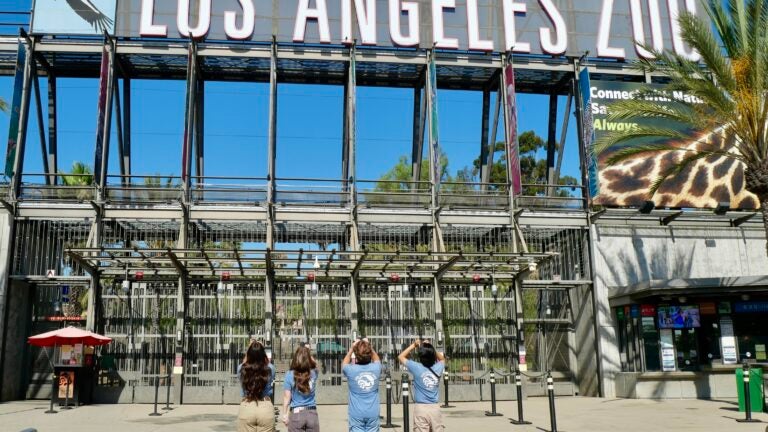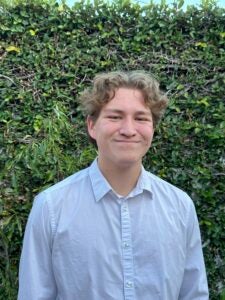
Jake Tanda and his peers call themselves the “Free Birds,” after conducting research together through their internships with the Los Angeles Zoo. (Courtesy of Jake Tanda)
Observing native birds in pollinator friendly habitats at the L.A. Zoo
Our mornings started at 8 a.m. The sun beamed down on the black asphalt that we walked on day after day. You’d hear someone call out the time of day and temperature to record, then the occasional joke of the weather being characteristically sunny and clear.
Right after, we’d start the timer and sit silence with binoculars raised to our eyes for the next 20 minutes. Observations were scribbled down hastily, as we could miss the next in the blink of an eye–from the rapid fluttering of an Allen’s hummingbird feeding from a purple flower, to the stoic gaze of a Red-tailed hawk perching at the highest point of a tree.

My name is Jake Tanda, I am a sophomore pursuing my B.S. in environmental studies. This summer I had the privilege of being a conservation intern at the Los Angeles Zoo and Botanical Gardens, made possible by the Wrigley Institute Environmental Summer Award.
Conservation has been a long-standing passion of mine, despite not fully knowing what “conservation” meant. My fascination with the natural world has persisted throughout my life, from wondering how anthropogenic sources have altered the environment on a global scale, to questioning what species of plant I was seeing on a hike. It wasn’t until this summer that I was able to link this interest to conservation beyond biology or environmental science.
Through this internship, I learned about the Zoo’s recent Project Pollinator initiative, which aids in the goal of the Saving Animals From Extinction (SAFE) program. Due to a variety of anthropogenic sources such as pesticide use, rising temperatures, and habitat loss, critical pollinator species are declining at an alarming rate, and the Zoo is taking action to educate more people on this issue, as well as to create more habitat for native wildlife. A key part of SAFE’s efforts are conserving North American Songbirds (NAS), which include over 300 species of native birds.
Seeing as we were given freedom to research topics that were most interesting to us, I found that my time would be best spent researching native bird species in and around the Zoo. My group came together through our shared appreciation of birds. Our primary goal was to learn which gardens across the Zoo campus were most successful in creating habitat for local bird species. We were most interested in the bird gardens (mostly non-native plants), general gardens (mix of native and non-native plants not specifically created for wildlife) and the pollinator gardens (newer gardens designed to benefit pollinator species, composed entirely of native plants). Our project sought to learn how we can provide more beneficial habitat to the native bird species of Los Angeles.
Each day, we randomly selected 4 of our 8 sites and conducted 20 minute point-count surveys of the species observed, their behavior, the time of the observation, and location in the garden. The four of us conducted our surveys together to ensure our counts were accurate. By the end of the data collection period, we had reached a total of 416 observations across forty surveys.
With our observations, we were then able to analyze the data using various statistical methods to explain what our observations were showing us. We found a significant difference between the amount of counts between the pollinator gardens, bird gardens, and general gardens. Through our interpretation, we discovered that the gardens that are closer to undeveloped areas around the Zoo are more likely to attract birds since they are more similar to their natural habitats. However, many birds still utilized all of the gardens throughout the Zoo.
My group, formally named Free Birds, quickly became friends beyond the scope of our internship. Our unique backgrounds and personalities meshed in a way that made conducting research exciting and fresh. Whether it was prior knowledge of birds that paved the way for our methodology and data collection, statistical expertise that gave us a clear picture of how the data was relevant, or an eye for design that aided in making our research digestible, our unique skills and talents were all necessary in this project.
My experience at the LA Zoo completely changed how I viewed conservation. Action towards conservation can be taken at any level–an action as simple as recycling, composting, or planting more native flora in gardens is a conservation effort.
Beyond our fieldwork, an especially exciting part of our day was lunch, which meant we got to have the Reggie’s special for that day (the special available at Reggie’s Grill for staff which rotated daily). For weeks, we ate the Reggie’s special and meticulously ranked each of them on the Reggie’s scale (our scale for determining, objectively, how good the special was between 1 and 10). The best special, we came to agree, was the Chicken and Waffles, with an average score of 9.3. Our lunchtime conversations and debates over rankings highlighted how far we had come since our first day.
My experience at the LA Zoo completely changed how I viewed conservation. Action towards conservation can be taken at any level–an action as simple as recycling, composting, or planting more native flora in gardens is a conservation effort. Everyone has a role in conserving the natural world, and through this experience I gained the knowledge of how I can promote more conservation efforts locally. After eight weeks of designing a project, conducting research, synthesizing results, and presenting my findings, I gained an entirely new perspective to what “conservation” meant. Best said by the Zoo’s vision statement: “Creating a just and sustainable world where people and wildlife thrive, together.”